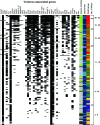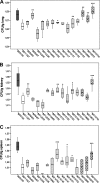Intestine and environment of the chicken as reservoirs for extraintestinal pathogenic Escherichia coli strains with zoonotic potential
- PMID: 18997030
- PMCID: PMC2612213
- DOI: 10.1128/AEM.01324-08
Intestine and environment of the chicken as reservoirs for extraintestinal pathogenic Escherichia coli strains with zoonotic potential
Abstract
Although research has increasingly focused on the pathogenesis of avian pathogenic Escherichia coli (APEC) infections and the "APEC pathotype" itself, little is known about the reservoirs of these bacteria. We therefore compared outbreak strains isolated from diseased chickens (n = 121) with nonoutbreak strains, including fecal E. coli strains from clinically healthy chickens (n = 211) and strains from their environment (n = 35) by determining their virulence gene profiles, phylogenetic backgrounds, responses to chicken serum, and in vivo pathogenicities in a chicken infection model. In general, by examining 46 different virulence-associated genes we were able to distinguish the three groups of avian strains, but some specific fecal and environmental isolates had a virulence gene profile that was indistinguishable from that determined for outbreak strains. In addition, a substantial number of phylogenetic EcoR group B2 strains, which are known to include potent human and animal extraintestinal pathogenic E. coli (ExPEC) strains, were identified among the APEC strains (44.5%) as well as among the fecal E. coli strains from clinically healthy chickens (23.2%). Comparably high percentages (79.2 to 89.3%) of serum-resistant strains were identified for all three groups of strains tested, bringing into question the usefulness of this phenotype as a principal marker for extraintestinal virulence. Intratracheal infection of 5-week-old chickens corroborated the pathogenicity of a number of nonoutbreak strains. Multilocus sequence typing data revealed that most strains that were virulent in chicken infection experiments belonged to sequence types that are almost exclusively associated with extraintestinal diseases not only in birds but also in humans, like septicemia, urinary tract infection, and newborn meningitis, supporting the hypothesis that not the ecohabitat but the phylogeny of E. coli strains determines virulence. These data provide strong evidence for an avian intestinal reservoir hypothesis which could be used to develop intestinal intervention strategies. These strains pose a zoonotic risk because either they could be transferred directly from birds to humans or they could serve as a genetic pool for ExPEC strains.
Figures



References
-
- Antão, E.-M., S. Glodde, G. Li, T. Homeier, C. Laturnus, I. Diehl, A. Bethe, H.-C. Philipp, R. Preisinger, L. H. Wieler, and C. Ewers. 20 September 2008, posting date. The chicken as a natural model for extraintestinal infections caused by avian pathogenic Escherichia coli (APEC). Microb. Pathog. doi:10.1016/j.micpath.2008.005. - DOI - PubMed
-
- Barnes, H. J., and W. B. Gross. 1999. Colibacillosis, p. 131-141. In W. B. Gross (ed.), Diseases of poultry, 10th ed. Iowa State University Press, Ames.
-
- Bingen, E., B. Picard, N. Brahimi, S. Mathy, P. Desjardins, J. Elion, and E. Denamur. 1998. Phylogenetic analysis of Escherichia coli strains causing neonatal meningitis suggests horizontal gene transfer from a predominant pool of highly virulent B2 group strains. J. Infect. Dis. 177:642-650. - PubMed
Publication types
MeSH terms
Substances
LinkOut - more resources
Full Text Sources
Other Literature Sources
Medical

